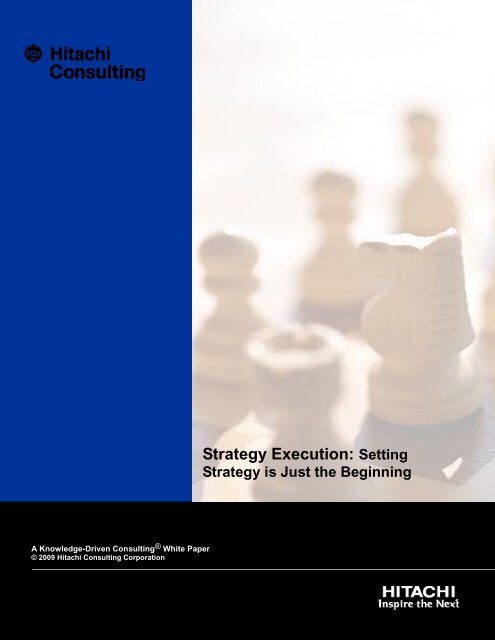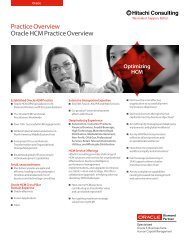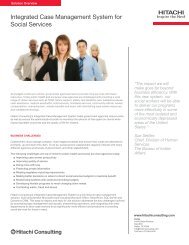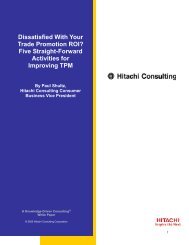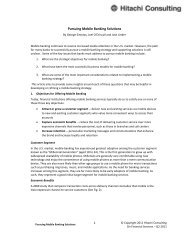Strategy Execution: Setting - Hitachi Consulting
Strategy Execution: Setting - Hitachi Consulting
Strategy Execution: Setting - Hitachi Consulting
You also want an ePaper? Increase the reach of your titles
YUMPU automatically turns print PDFs into web optimized ePapers that Google loves.
<strong>Strategy</strong> <strong>Execution</strong>: <strong>Setting</strong><br />
<strong>Strategy</strong> is Just the Beginning<br />
A Knowledge-Driven <strong>Consulting</strong> ® White Paper<br />
© 2009 <strong>Hitachi</strong> <strong>Consulting</strong> Corporation<br />
1
Table of Contents<br />
Why Don’t Good Strategies Lead to Good Results? ................................. 3<br />
The Path Toward Advanced Business Planning ........................................ 4<br />
How <strong>Strategy</strong> <strong>Execution</strong> Works ................................................................... 6<br />
The Roads Merge: Integration ...................................................................... 6<br />
Summary ...................................................................................................... 10<br />
About <strong>Hitachi</strong> <strong>Consulting</strong> Corporation ...................................................... 11<br />
About <strong>Hitachi</strong> ............................................................................................... 11<br />
2
Every year, companies invest an extraordinary amount of time, money and effort<br />
into the creation of the perfect strategic plan. A well-planned road map for<br />
success. Yet few companies actually reach their destination.<br />
A recent study of companies with over $500M in revenue found that more than<br />
66% set targets that exceeded 9% real growth, yet less than one company in 10<br />
achieved this level of success i . In fact, of the companies analyzed only 13% were<br />
able to achieve 5.5% compound annual growth rates while providing shareholder<br />
returns in excess of their cost of capital. Clearly, there is a significant roadblock<br />
between the strategic plans these companies develop and the results they<br />
achieve.<br />
Why Don’t Good Strategies Lead to Good Results?<br />
The performance gap between strategy creation and benefit realization is<br />
frequently a company’s inability to execute the strategies they define. Larry<br />
Bossidy, the former CEO at Allied Signal and Honeywell, and the co-author of<br />
<strong>Execution</strong>: the Discipline of Getting Things Done, said it like this: “Corporate<br />
strategies are intellectually simple; their execution is not. The question is, can<br />
you execute? That’s what differentiates one company from another.”<br />
So what makes this road to strategic execution so precarious? The most commonly<br />
identified potential hazards can be grouped into four basic categories: Clarification,<br />
Communication, Alignment and Measurement.<br />
Clarification<br />
A strategy must be a tangible, relevant statement of business intent, rather than a<br />
collection of broad, sweeping statements that force individual interpretation. The<br />
strategies often lean heavily on financial outcomes as the destination, without<br />
specifying the roadmap of objectives that drive those expected results. For example,<br />
a company may claim that they will be #1 and double revenue in five years, without<br />
providing any insight into what value proposition, customer segment, geography,<br />
product or channel will differentiate them in the marketplace and make these goals a<br />
reality. Without clear connections between the drivers, actions, outcomes and<br />
rewards, a strategy is irrelevant to the organization as a whole.<br />
Poor clarification of the value proposition, in particular, is not a trivial detour on this<br />
journey. The value proposition is the archstone of an organization’s overall strategy.<br />
The extent to which a company can provide a relevant, differentiated value<br />
proposition to its customers not only drives financial performance, it provides valuable<br />
insight into the processes, competencies and culture it must cultivate to be<br />
successful.<br />
The benefit of creating a clear value proposition is evident at a company like<br />
Southwest Airlines: the low-cost, high performing carrier. Southwest uses this<br />
concisely stated value proposition to prioritize investment in people, processes and<br />
technology, thus delivering optimal value to its customers. At many companies,<br />
however, this value proposition is uncertain or unshared, even among executive team<br />
members. If a company cannot clearly and crisply define the value it provides<br />
internally, it is hard to imagine that value being clear to external customers.<br />
Communication<br />
Even when clearly defined, strategy isn’t always effectively communicated. Often, an<br />
organization’s size and complexity makes communication of even the most concise<br />
strategy statements challenging. Establishing a common language for<br />
communicating strategy, and enabling that communication at every level is nearly as<br />
important as creating the strategy itself.<br />
Alignment<br />
Clear, concise strategies that are effectively communicated still can’t drive significant<br />
value unless the entire organization understands how their individual actions are<br />
strategically aligned. In many cases, strategies are defined at the pinnacle of an<br />
organization, with no clear cascade of responsibility for the tactical specifics<br />
necessary to achieve results. High-level strategies must be broken down into specific<br />
3
sub-objectives, which can then be owned and executed at every organizational level.<br />
Measurement<br />
A final obstacle on the road to strategic execution is the inability of most companies<br />
to accurately measure true strategic performance. Too many organizations focus<br />
measurement efforts on lagging financial outcomes (lag indicators) instead of key<br />
drivers of performance (leading indicators). As a result, intangible assets are typically<br />
undervalued or not measured at all. These intangible assets can account for 80% of<br />
a company’s valuation, and are the key levers to pull when making corrective actions.<br />
Examples of intangible assets include management effectiveness, process<br />
excellence, brand recognition and innovation. Focus on tangible assets alone, like<br />
financial results and budget discrepancies, limits management’s view of performance<br />
to past performance alone. To effectively measure past performance and make<br />
accurate predictions of future performance a more holistic approach to measurement<br />
is necessary.<br />
The Path Toward Advanced Business Planning<br />
A key first step along the path to successful strategy execution is the creation of a<br />
concise, but holistic, description of the strategy. One of the most commonly used<br />
frameworks for this exercise is the Balanced Scorecard. The approach,<br />
developed by Dr. Robert Kaplan and Dr. David Norton, has undergone nearly 15<br />
years of enhancement through academic research and practical application by<br />
leading organizations. Part of these enhancements, a tool called a <strong>Strategy</strong> Map,<br />
is one of the most effective mechanisms for developing a clear, crisp roadmap of<br />
an organization’s strategic intent.<br />
The <strong>Strategy</strong> Map is, at the highest level, a model for how an organization creates<br />
value. It uses this model as a lens to identify the critical few objectives, measures<br />
and initiatives required to drive performance. The <strong>Strategy</strong> Map incorporates the<br />
Balanced Scorecard concept of breaking the strategy down into (typically) four<br />
interrelated perspectives: Financial, Customer, Internal Process and Learning &<br />
Growth ii . The figure (Figure 1) below outlines these perspectives and<br />
demonstrates how the objectives in the latter two perspectives (Learning &<br />
Growth, Internal Process) drive the outcomes in the former (Customer, Financial).<br />
Figure 1<br />
4
A <strong>Strategy</strong> Map breaks a company’s strategy into constituent parts and puts in<br />
place an approach for reporting on not only the company’s performance, but also<br />
on the overall effectiveness of the company’s strategic hypothesis. Companies<br />
measure performance on the strategy by evaluating how well they performed<br />
against the targets they associated with each objective (the boxes in Figure 1).<br />
The <strong>Strategy</strong> Map also enables executives to measure the accuracy of their<br />
strategic hypothesis by gauging how accurately they anticipated the cause and<br />
effect relationships between objectives (the arrows in Figure 1). With the key<br />
objectives and measures clearly articulated in the <strong>Strategy</strong> Map, the next step is<br />
to link these objectives to the individuals or groups responsible for their<br />
achievement and key initiatives that will drive their results.<br />
Once the top-level <strong>Strategy</strong> Map is complete and communicated, the strategy for<br />
the organization should be clearer and more understandable to all stakeholders.<br />
The next step in the approach is often to link and align departmental strategy with<br />
enterprise strategy via “cascading” strategy maps and scorecards. The goal is to<br />
make the measures relevant and actionable for each individual that uses the<br />
<strong>Strategy</strong> Map tool. Ideally this is done in a “top-down” manner, using the<br />
enterprise level strategy map and scorecard as a guidepost. As the diagram<br />
below (Figure 2) demonstrates, each sub-scorecard should be closely aligned<br />
with the superior scorecard, insuring strategic alignment and actionable measures<br />
across the organization.<br />
QUARTERLY PERFORMANCE SCORECARD<br />
BUSINESS UNIT<br />
Overall<br />
SCORE<br />
xx.x%<br />
Scorecard<br />
FINANCIAL ACT TAR SCORE<br />
Y-on-Y Same Store Sales $x.xx $x.xx xx.x%<br />
CUSTOMER ACT TAR SCORE<br />
Mystery Shopper Rating x x xx.x%<br />
Price Match Rebates x x xx.x%<br />
INTERNAL PROCESSES ACT TAR SCORE<br />
Average Wait Time x x xx.x%<br />
Revenue Sq/Ft/ x x xx.x%<br />
INTERNAL PROCESSES ACT TAR SCORE<br />
# Price Checks x x xx.x%<br />
# Stock-outs x x xx.x%<br />
Scorecard<br />
Dept.<br />
Scorecard 1<br />
Team<br />
Scorecard x<br />
Ind.<br />
SC y<br />
QUARTERLY PERFORMANCE SCORECARD<br />
QUARTERLY PERFORMANCE SCORECARD<br />
BUSINESS UNIT<br />
QUARTERLY PERFORMANCE SCORECARD<br />
BUSINESS Overall<br />
UNIT<br />
QUARTERLY PERFORMANCE SCORECARD<br />
xx.x%<br />
SCORE<br />
BUSINESS Overall<br />
UNIT<br />
xx.x%<br />
SCORE<br />
BUSINESS Overall<br />
UNIT<br />
xx.x%<br />
SCORE<br />
FINANCIAL Overall<br />
ACT TAR SCORE<br />
xx.x%<br />
FINANCIAL Y-on-Y Same Store Sales $x.xx ACT $x.xx TAR xx.x%<br />
SCORE<br />
FINANCIAL Y-on-Y Same Store Sales $x.xx ACT $x.xx TAR xx.x%<br />
SCORE<br />
FINANCIAL Y-on-Y Same Store Sales $x.xx ACT $x.xx TAR xx.x%<br />
SCORE<br />
Y-on-Y Same Store Sales $x.xx $x.xx xx.x%<br />
CUSTOMER ACT TAR SCORE<br />
Mystery CUSTOMER Shopper Rating x ACT x TAR xx.x%<br />
SCORE<br />
Price Mystery CUSTOMER Match Shopper Rebates Rating x x ACT x x TAR xx.x%<br />
xx.x%<br />
SCORE<br />
Price Mystery CUSTOMER Match Shopper Rebates Rating x x ACT x x TAR xx.x%<br />
xx.x%<br />
SCORE<br />
Price Mystery Match Shopper Rebates Rating x x x x xx.x%<br />
xx.x%<br />
INTERNAL PROCESSES ACT TAR SCORE<br />
Price Match Rebates x x xx.x%<br />
Average INTERNAL Wait PROCESSES Time x ACT x TAR xx.x%<br />
SCORE<br />
Revenue Average INTERNAL Sq/Ft/ Wait PROCESSES Time x x ACT x x TAR xx.x%<br />
xx.x%<br />
SCORE<br />
Revenue Average INTERNAL Sq/Ft/ Wait PROCESSES Time x x ACT x x TAR xx.x%<br />
xx.x%<br />
SCORE<br />
Revenue Average Sq/Ft/ Wait Time x x x x xx.x%<br />
xx.x%<br />
INTERNAL PROCESSES Revenue Sq/Ft/ ACT x TAR x SCORE<br />
xx.x%<br />
# INTERNAL Price Checks PROCESSES x ACT x TAR xx.x%<br />
SCORE<br />
# Stock-outs # INTERNAL Price Checks PROCESSES x x ACT x x TAR xx.x%<br />
xx.x%<br />
SCORE<br />
# Stock-outs # INTERNAL Price Checks PROCESSES x x ACT x x TAR xx.x%<br />
xx.x%<br />
SCORE<br />
# Stock-outs # Price Checks x x x x xx.x%<br />
xx.x%<br />
# Stock-outs x x xx.x%<br />
Targeted Sweetspot for<br />
Strategic Performance Dialogue:<br />
“Bridge the Gap”<br />
Dept.<br />
Scorecard 1<br />
Team<br />
Scorecard x<br />
Ind.<br />
SC y<br />
Operational Analytics<br />
<strong>Strategy</strong> Maps & Scorecards provide framework, focus and simplification.<br />
This facilitates:<br />
1. crisp, clean storytelling during conversations;<br />
2. broader involvement in the formulation of strategy; and<br />
3. a process for discussing strategic interaction across departments.<br />
Figure 2<br />
The completed and cascaded <strong>Strategy</strong> Maps will serve not only as useful<br />
clarification tools for defining what is, and what is not, a part of the strategy, it will<br />
also serve as a valuable communication tool for educating the entire organization<br />
on what executives deem to be important. It should also begin to insure that all<br />
parts of the company have a “line-of-sight” between their actions on a daily basis<br />
and the company’s overall strategy.<br />
Still, the value of these tools will quickly be lost if the process for using them as a<br />
critical measurement approach is not addressed. It is the creation of the rhythm<br />
of use that begins to engrain strategy into the operation of the company and is the<br />
only way to begin to generate lasting value from the Scorecard exercise.<br />
<strong>Strategy</strong> Maps are a Good First Step<br />
Even companies that implement the scorecard approach, however, often find that<br />
they are not achieving their expected levels of benefit. Despite clarifying,<br />
communicating, aligning and measuring their strategy; despite linking initiatives<br />
that will drive strategy improvement and identifying owners for measures and<br />
initiatives…performance may not get better. A study by Bain & Company found<br />
5
that the Balanced Scorecard was in use by over 60% of 6000+ respondents,<br />
making it one of the most popular management tools in use today iii . Yet, as<br />
mentioned earlier, only one in 10 companies is successfully creating significant<br />
value. What is causing this discrepancy?<br />
Two culprits may be primarily to blame. One possibility is that companies are not<br />
implementing the Balanced Scorecard framework as it was intended. The ways<br />
to sub-optimize the effort are plentiful: they may not truly be making significant<br />
measures non-financial, they may not be identifying cause and effect linkages,<br />
they may not be getting management buy-in to the approach, they may not be<br />
linking initiatives to the performance objectives, etc. The Balanced Scorecard<br />
Collaborative has estimated that half of Scorecard efforts are not implemented<br />
in the manner that Kaplan and Norton have proposed iv . Still, that leaves as<br />
much as 2/3 of the companies that are using the Balanced Scorecard correctly<br />
with approaches that do not provide significant creation of value. So, what is<br />
left to be done?<br />
How <strong>Strategy</strong> <strong>Execution</strong> Works<br />
The primary reason strategies do not reach their intended destinations, is that<br />
companies stop short of creating an integrated approach for strategy execution.<br />
The Balanced Scorecard framework is an excellent approach for clarifying what is<br />
important, for communicating what is important, for aligning the organization with<br />
what is important and for creating a process from measuring performance.<br />
Simply putting a Scorecard in place (actually, often not so simple), however, is<br />
just the first step. If the organization’s description of the strategy is not integrated<br />
with the management rhythms of the business, the link between strategy and<br />
tactics will not be complete. The Scorecard is just one component of the full<br />
corporate performance management system necessary to not only measure<br />
strategy, but also:<br />
• to set strategy;<br />
• to allocate and manage resources in alignment with that strategy;<br />
• to align human capital with the strategy; and<br />
• to generate, organize and distribute the underlying detailed information<br />
necessary to make decisions.<br />
The Roads Merge: Integration<br />
By leveraging the Balanced Scorecard approach, organizations can begin to<br />
integrate the amalgam of strategic and tactical management processes that<br />
typically operate in, at best, a loosely coordinated manner. The figure below<br />
(Figure 3) demonstrates how cascading scorecards merge with the broader<br />
performance management framework, and provide an example of the<br />
management rhythms necessary to engrain and sustain the scorecard effort<br />
long term.<br />
6
Figure 3<br />
The most successful organizations integrate key processes, establish the<br />
recurring rhythms, and implement the tools required to make this system<br />
sustainable and agile.<br />
<strong>Strategy</strong> Formulation<br />
The integration of <strong>Strategy</strong> Formulation with the actual processes that drive<br />
company performance increases the probability of successful strategic execution<br />
significantly. However, for true integration to occur, <strong>Strategy</strong> Formulation must<br />
deliver a description of the strategy (often using a <strong>Strategy</strong> Map) which outlines<br />
specific strategic objectives the company believes will produce its desired<br />
financial outcomes. These objectives should:<br />
• be balanced across perspectives;<br />
• push the organization beyond status quo;<br />
• be actionable, measurable and concise; and<br />
• expose cause and effect (tying drivers to outcomes).<br />
Knowing that strategy must be clarified for all perspectives (Financial, Customer,<br />
Process and Learning & Growth) will help to insure that <strong>Strategy</strong> Formulation is<br />
holistic, rather than simply financial, in nature.<br />
Initiative Rationalization<br />
The Initiative Rationalization exercise is the vetting process that ultimately<br />
determines funding. With a <strong>Strategy</strong> Map in place to provide direction, integrated<br />
Initiative Rationalization ensures the projects and programs most critical to<br />
strategic execution are appropriately weighted. Funding will not be haphazardly<br />
influenced by corporate gamesmanship, political clout or PowerPoint slides<br />
detailing lofty intentions to drive returns. For this to work, first, existing and<br />
prospective initiatives are inventoried and linked to the <strong>Strategy</strong> Map objectives<br />
they support. Then, the owners of objectives granted supporting initiatives must<br />
account for this commitment of resources in the form of more aggressive targets.<br />
Objectives with no supporting action items should be flagged for evaluation. It is<br />
7
unrealistic to expect improved performance without some form of intervention.<br />
Best practices include:<br />
• differentiate tactical and baseline from strategic;<br />
• prioritize initiatives on strategic fit and value (e.g. NPV);<br />
• discontinue initiatives lacking strategic linkage;<br />
• adequate funding for initiatives; and<br />
• assign accountability for initiatives<br />
A common problem with predicting and calculating actual value from initiatives is<br />
the complexity involved with defining the costs associated with their<br />
implementations. Without visibility into how “staff”/salaried resources (e.g.<br />
marketing) spend their time, it’s extremely difficult to get a fully burdened P&L for<br />
a robust initiative. Activity-based Costing efforts can solve this issue by providing<br />
a mechanism for allocating implementation costs in a logical and insightful way.<br />
Initiative Management<br />
Once an initiative is approved, progress must be managed and tracked<br />
throughout the course of its development and implementation lifecycle.<br />
Organizations often have Program Management Offices to direct this effort, but<br />
they don’t always integrate the necessary criteria, including:<br />
• delivery dates;<br />
• scope changes;<br />
• budget issues;<br />
• project risks; and<br />
• milestones.<br />
Once this information is accessible, companies are able to integrate with the<br />
Performance Management process by translating how initiative status should<br />
affect KPI performance, targets and importance. As initiatives are executed, the<br />
corresponding targets need to be adjusted accordingly.<br />
<strong>Strategy</strong> Reporting<br />
The ability to manage and measure strategy is a fundamental weakness in many<br />
organizations, and the reason for the widespread adoption of frameworks like the<br />
Balanced Scorecard.<br />
KPI Considerations<br />
A KPI makes a strategic objective more explicit, timely and actionable<br />
Every objective should ideally have one or two measures<br />
Balance between leading and lagging measures<br />
Easily understood (complexity is bad)<br />
Generally quantifiable (may be subjective)<br />
Each KPI should have a target goal defined<br />
Target should reflect a “stretch”<br />
Understanding of relative importance (weighting)<br />
Relative targets if possible (benchmark)<br />
Accountability assigned for KPIs/Objectives<br />
The <strong>Strategy</strong> Map (or <strong>Strategy</strong> Description), as described earlier, is a very<br />
effective tool for documenting and communicating the strategic objectives,<br />
metrics, initiatives, accountabilities and targets for the. The most important<br />
aspect of <strong>Strategy</strong> Reporting effort, however, is not the <strong>Strategy</strong> Map itself; it is<br />
how the map is used. The best map in the world does not help a driver that does<br />
not know how to read it. Regularly scheduled sessions (preferably monthly or<br />
quarterly) to review performance, evaluate strategy, and redirect resources must<br />
be created and managed. All stakeholders should understand the following items:<br />
• the participants in the review session;<br />
• the agenda of topics;<br />
• the expectations for participation;<br />
• the process for review and revision of measures and targets; and<br />
• the accountabilities for action.<br />
8
Performance Management<br />
In many companies, individual and group incentives are focused on<br />
subjective evaluation of performance against goals that may or may not<br />
be aligned with overall strategy. It has been estimated that only 25% of<br />
managers have their personal objectives linked to strategy v . If personal<br />
and group incentives are not aligned with company intentions, driving<br />
desired performance is nearly impossible.<br />
For strategy execution to become an organizational strength, clear accountability<br />
for strategic objectives/initiatives must be in place to focus and align individuals<br />
with organizational goals. The <strong>Strategy</strong> Reporting “scorecard” that provides<br />
overall feedback on the performance of the organization can be leveraged to<br />
accomplish this goal. By using the same approach for creating performance<br />
objectives for individuals/groups all employees are given personal objectives that<br />
are aligned with organizational goals. Key points:<br />
• high level (BU) performance and individual goals must be closely linked<br />
• the focus of performance management shifts to strategic objectives<br />
• cascading of objectives down to the individual level may be appropriate<br />
The individual/group scorecard can easily be derived from the high-level<br />
scorecards since accountability has been established up front. Potential changes<br />
include the following:<br />
• accountability for metrics that are now directly tied to desired outcomes<br />
• more balance in performance measurement…not just financials<br />
• weighting of KPIs provides relative level of importance guidance<br />
Multi-year Plan and Rolling Forecast<br />
Jack Welch, the ex-CEO of GE has identified budgeting as no less than “the bane<br />
of corporate America”. In fact, it has been estimated that as much as 90% of<br />
companies are dissatisfied with their budgeting and planning processes vi . The<br />
reasons for this dissatisfaction are numerous, but include the following:<br />
• budgets are not strategy driven – the culture of X% over last year prevails<br />
• budgets do not reduce costs – the spend-it-or-lose-it mindset can actually<br />
increase costs<br />
• budgets stifle innovation – encourage employees to focus on meeting<br />
budget, not driving growth<br />
• budgets prevent responsiveness – only 1 in 5 firms change budgets within<br />
a cycle<br />
• budgets are different than planning and forecasting – the business<br />
requirements for each exercise are different, the deliverable should<br />
be as well<br />
A solution to these problems requires companies to take the, often uncomfortable,<br />
step of integrating their budgeting and planning process with the CPM effort. This<br />
integration is best accomplished by syncing its timing with the strategy formulation<br />
and description processes, allowing strategy, as documented in the <strong>Strategy</strong><br />
Map/<strong>Strategy</strong> Description, to define and set stretch targets for both the long- and<br />
short-term organizational objectives. Specific best practices for making this<br />
integration successful include:<br />
• Scenario Based Modeling<br />
• macro driver assumptions that impact strategy<br />
• KPI (controllable) targets fed from strategy<br />
• driver based Rolling Forecast (4-6 Quarters)<br />
• flexible/relative targets<br />
• tolerance driven by business maturity<br />
• external benchmarks (if possible)<br />
9
Operational Analytics<br />
The <strong>Strategy</strong> Reporting scorecard holds strategic-level measures that provide a<br />
crisp, concise view of performance. It does not, however, provide the detailed,<br />
multidimensional view of information that is necessary to make decisions on what<br />
actions must be taken to correct or sustain performance. Coming out of the<br />
holiday season, a particularly relevant analogy for the difference between<br />
operational analytics and strategic-level measures is a person’s weight. <strong>Strategy</strong><br />
Reporting measures can tell a person that they weigh too much. This is obviously<br />
important information to have, but to make a decision on how best to rectify the<br />
situation, additional information may need to be collected and analyzed. How<br />
long has this person been overweight? Does this person have a medical<br />
condition that would make exercise difficult? Are there dietary considerations that<br />
should be investigated? The answer to these questions would be solved by the<br />
equivalent of operational analytics. The key is to insure that the appropriate<br />
information is accessible when needed, and focused on the strategic measures<br />
they are intended to support.<br />
<strong>Strategy</strong> drives the need to understand not only KPI results but also very<br />
specific data sets that add context to why hypotheses are proving true or<br />
false. The following information should be readily available to support strategic<br />
decision-making:<br />
• KPI results for strategy reports and rolling forecast;<br />
• supporting granularity for KPIs (e.g. hierarchical breakdown); and<br />
• contextual information (e.g. segment, geography views).<br />
Summary<br />
Many organizations spend a significant amount of effort and money creating lofty<br />
roadmaps for success that, more often than not, doesn’t lead the company to its<br />
intended destination. The reason companies lose their way is not because they<br />
are unable to craft a good strategic roadmap, it is because they don’t have the<br />
mechanisms in place to keep their car on the road. Tools like the Balanced<br />
Scorecard help organizations effectively clarify their strategy in a holistic manner,<br />
communicate the strategy to all stakeholders, align all departments behind the<br />
strategy, and measure strategic performance. Without connecting the<br />
Scorecard’s roadmap for success to the management processes that steer the<br />
business, however, true value creation will still be elusive. Integration of these<br />
critical management processes enables companies to effectively execute<br />
strategy, to reach their intended destinations. To paraphrase Robert Frost, that<br />
can make all the difference.<br />
10
About <strong>Hitachi</strong> <strong>Consulting</strong> Corporation<br />
As <strong>Hitachi</strong>, Ltd.'s (NYSE: HIT) global consulting company, with operations in the<br />
United States, Europe and Asia, <strong>Hitachi</strong> <strong>Consulting</strong> is a recognized leader in<br />
delivering proven business and IT strategies and solutions to Global 2000<br />
companies across many industries. With a balanced view of strategy, people,<br />
process and technology, we work with companies to understand their unique<br />
business needs, and to develop and implement practical business strategies and<br />
technology solutions. From business strategy development through application<br />
deployment, our consultants are committed to helping clients quickly realize<br />
measurable business value and achieve sustainable ROI.<br />
<strong>Hitachi</strong> <strong>Consulting</strong>'s client base includes 25 percent of the Global 100 as well as<br />
many leading mid-market companies. We offer a client-focused, collaborative<br />
approach and transfer knowledge throughout each engagement.<br />
For more information, call 1.877.664.0010 or visit www.hitachiconsulting.com.<br />
About <strong>Hitachi</strong><br />
<strong>Hitachi</strong>, Ltd., (NYSE: HIT / TSE: 6501), headquartered in Tokyo, Japan, is a<br />
leading global electronics company with approximately 390,000 employees<br />
worldwide. Fiscal 2007 (ended March 31, 2008) consolidated revenues totaled<br />
11,226 billion yen ($112.2 billion). The company offers a wide range of systems,<br />
products and services in market sectors including information systems, electronic<br />
devices, power and industrial systems, consumer products, materials, logistics<br />
and financial services. For more information on <strong>Hitachi</strong>, please visit the company's<br />
website at http://www.hitachi.com.<br />
© 2009 <strong>Hitachi</strong> <strong>Consulting</strong> Corporation. All rights reserved. "Inspiring your next success!" and "Knowledge-Driven<br />
<strong>Consulting</strong>" are registered service marks of <strong>Hitachi</strong> <strong>Consulting</strong> Corporation. “Building the Market Responsive Company,”<br />
“Business Intelligence at the Edge of the Enterprise” and “Performance Management at the Edge of the Enterprise” are all<br />
service marks of <strong>Hitachi</strong> <strong>Consulting</strong> Corporation.<br />
i Chris Zook and James Allen, Profit from the Core: Growth <strong>Strategy</strong> in an Era of<br />
Turbulence, Harvard Business School Press (February 2001)<br />
ii Robert Kaplan and David Norton, The <strong>Strategy</strong>-Focused Organization: How<br />
Balanced Scorecard Companies Thrive in the New Business Environment, Harvard<br />
Business School Press (September, 2000)<br />
iii Darrell Rigby, Management Tools 2003, Bain & Company<br />
iv Balanced Scorecard Collaborative, North American Summit, New Orleans, LA<br />
(2003)<br />
v Balanced Scorecard Collaborative, North American Summit, New Orleans, LA<br />
(2003)<br />
vi Jeremy Hope and Robin Fraser, Beyond Budgeting: How Managers Can Break<br />
Free from the Annual Performance Trap, Harvard Business School Press (April 2003)<br />
11


